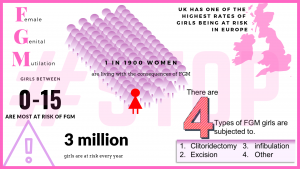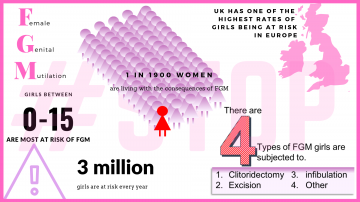FGM is not just a woman’s issue, it’s a human rights issue
By Emma Beavon
“It’s time for you to become a woman” her father said. She knew exactly what he meant. While everyone else celebrated she was pinned to a table by four other women. She then felt her flesh being cut into. With the sounds of her family singing and celebrating, she was mutilated.
This was the real-life story of a girl who would like to stay anonymous, and is the reality for many girls in the Middle East, Asia and Africa. But what’s little-known and close to home is this is the reality for an estimated 137,000 women and girls in England and Wales.
What these girls are being forced to undergo is female genital mutilation (FGM) or female circumcision. However, unlike male circumcision there are absolutely no benefits for girls being subjected to this as it causes major health risks. FGM is the partial or total removal of the external female genitalia for non-medical reasons. Some communities practice FGM as a part of their tradition however as Naomi Reid, from FORWARD a foundation committed to gender equality and safeguarding the rights of African girls and women, said, “There are no health benefits to FGM and it is recognised internationally as a human rights violation.”
Ms Reid also explained that there are four types of FGM that girls all around the world are subjected to every day. The first type is a clitoridectomy which is the partial or total removal of the clitoris. The second type is excision, the partial or total removal of the clitoris and the labia minor. The most sever kind of FGM, the type that our case study had to experience, is infibulation, the narrowing of the vaginal opening through the creation of a covering seal. This means that a seal is formed by cutting and sewing over the outer labia, with or without the removal of the clitoris or inner labia. This seal then covers the urethra and vagina. The final type is any other harmful procedures including pricking, piercing, cutting, scraping or burning the area.

The health risks of FGM include shock and haemorrhaging could take place during the cutting ritual which can at times lead to death. The procedure will lead to damaging of the urethra making it harder for the girls to urinate and therefore lead to urine infections. They could later experience chronic vaginal and pelvic infection due to the cutting. Along with risks to other organs, the procedure that is supposed to welcome girls into womanhood can take their womanhood away by damaging their reproductive organs leaving them unable to conceive or safely carry and deliver a baby. This also means that because of the damaging to the reproductive system and the narrowing of the vagina will make sex an extremely painful and difficult process. Those who are lucky enough to still be fertile after the procedure and fall pregnant are at risk of having complications during pregnancy and labour which can lead to new born deaths.

Image by Emma Beavon: Razor blades, unsterilised scalpels, kitchen knives and scissors are used to perform the procedure.
Along with the physical trauma, these girls can suffer from PTSD, depression, anxiety, low self-esteem and shame because of the procedure.
Refuge has said that FGM continues for multiple reasons one of which is a way to control a girl’s sexuality and therefore is a form of gender-based violence that can be a manifestation of power. Many of the FGM procedure that happen are actually due to women putting pressure on other female family members this is because they have been brought up to believe that the circumcision is what is right and how girls will become a woman.
This was the background for a court case that is currently taking place in London. A man originally from Ghana and a Ugandan national woman have been accused of mutilating their 3-year-old daughter. The man and the woman, who cannot be named for legal reasons, were arrested last year. The woman appeared in court on the 31 of August 2018 where she plead not guilty. The man gave the same plea from jail where he was being held.
This will be Britain’s third attempted FGM prosecution even though FGM has been illegal in the UK since 1985. In the two previous prosecutions the suspects were acquitted. The maximum sentence for someone found guilty of performing FGM or aiding in the mutilation is 14 years in prison. Ms Reid however said that a girl who has undergone FGM will never be in trouble with the law herself.
The trial officially started on Monday the 14th of January 2019. In court on Monday, the prosecutor Caroline Carberry QC told the court that the little girl had been subjected to FGM at her mother’s house in the presence of her father. However, the mother denies this.
The girl was taken to Whipps Cross Hospital, in Laytonstone, as she had lost a significant amount of blood due to her injuries. At the hospital, social workers and officials were called to take the girl away and question the parents.
The reason why girls come into hospitals with excessive bleeding after being circumcised is because the people that perform the procedure are generally not medically trained. Antiseptics and anaesthetics are not normally used and knives, scissors, scalpels, pieces of glass and razor blades are among the tools chosen to perform the procedure.
Many FGM cases go unreported due to either lack of education or embarrassment or shame felt by the victims of this practice. Ms Reid urges girls to alert authorities or go seek support. “Although some young people might feel intimidated or embarrassed about discussing FGM or genitals, there are places you can go to, which are safe and where the staff are fully trained to deal with FGM.
“There is nothing wrong or shameful about asking for information or help on FGM, genitals, your body or your feelings in general.”

It is estimated that over 200 million women around the world alive today have undergone an FGM procedure with a further 3 million girls at risk of undergoing the procedure every year. However, officials think that this number might be higher as the practice still remains widely unreported.
Britain is not exempt from these numbers. In the UK, summer has become known as cutting season as families will take their daughters abroad to undergo the FGM procedure because of the laws protecting girls in Britain. Despite these laws, the UK has one of the highest rates of girls being at risk of becoming a victim of FGM in Europe.
In November 2018, the UK pledged £50 million to help put an end to FGM in Africa despite the fact that female circumcision is still an issue in the UK. However, as Ms Reid pointed out “Working with communities that still practice FGM is key to ending FGM.”. This is because people who practice FGM do so because of cultural beliefs and are generally not educated about the subject and its risks. Therefore, the eradication of the practice is reliant on a change in cultural beliefs and educating the public about the dangers and harmful nature of the procedure.
Ms Reid said, “We need to continue to raise awareness of the issue amongst communities, ensuring men are involved and that professionals who work with children are trained correctly in order to protect at risk girls.”
And these changes need to happen soon.
It is estimated by the World Heath Organisation that if current trends continue 15 million additional girls between 15 and 19 will be subjected to FGM by 2030.
As Jaha Dukureh, a FGM survivor and founder of Safe Hands for Girls, said “As young mothers, as survivors, as activists, as individuals, it doesn’t matter where you come from, we all have a moral obligation to see an end to FGM in our lifetime.”

